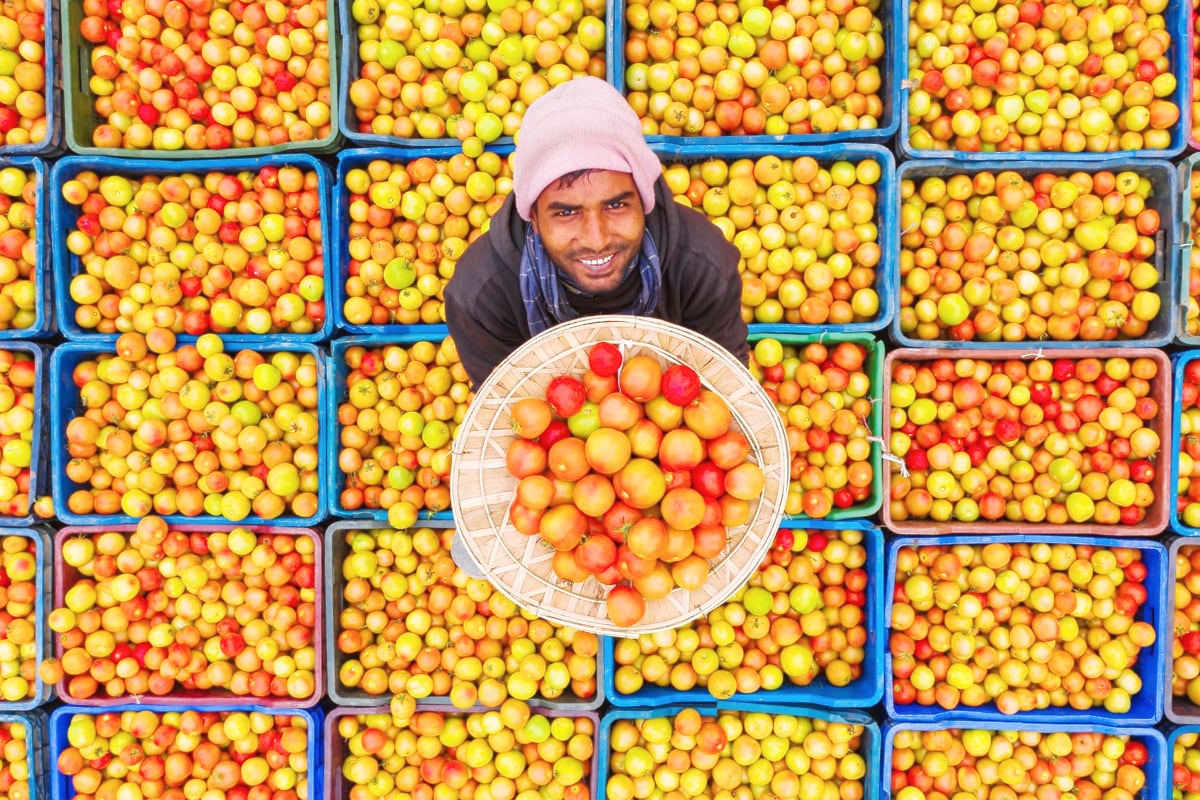
Climate Action: How Smart Farming Can Cool the Planet Down
The best way to reverse greenhouse emissions is to rethink agriculture and food production from the ground up, experts agree – because earth knows how to keep its temperature down. If we let it.
After more than a century of releasing greenhouse gases into the air, humans now face a new challenge: how to suck CO2 out of the atmosphere again – and safely store gigatons of the gas underground.
Technologists have come up with various ideas to keep global warming in check, or even reverse it, with concepts ranging from geo-engineering to huge industrial plants using “direct air capture” technologies.
Trouble is, most of these efforts are years away, very costly and hard to scale. If they even work.
The Solution Under Our Feet
Luckily, there is a proven, highly efficient method to remove carbon from the atmosphere quickly, all around the world. Wherever plants grow they extract CO2 from the air through photosynthesis – naturally, powered by energy from the sun.

Jan-Gisbert Schultze
Acton Capital Partners
“If we don’t cover the soil, it’s like a wound. If we tear off the plants from the soil, we’re tearing off our skin.”
It’s crucial, though, to preserve healthy soils, which contain about 2,500 gigatons of carbon dioxide – “more than three times the amount of carbon in the atmosphere”, as the Columbia Climate School points out.
This is where climate-smart agriculture comes in, which aims to increase food security for soon 9 billion people on earth while at the same time preserving the planet, rather than exploiting its resources.
Harvesting the potential of regenerative agriculture and more sustainable food production on a global scale promises to bring enormous benefits to people and planet, as expert talks at the recent DLD Munich conference showed. What’s needed is the will to invest in these opportunities and to rethink the current system from the ground up.
Carbon Capture, Farmer Style
Keeping greenhouse gases in the soil requires a different kind of farming – one that values biodiversity more than sheer efficiency. Because ultimately the benefits far outweigh the short-term cost increase.
“Nobody talks about it, but 20 to 30 percent of the carbon dioxide that we have in the atmosphere is actually coming from depleting the soils, not from burning fossil fuels”, Jan-Gisbert Schultze, Managing Partner at Acton Capital, pointed out at DLD23. “With our industrial monoculture agricultural system, we’re destroying the soil.”
Through the use of pesticides, farmers typically try to weed out anything that interferes with the industrial process of growing crops. But pesticides “are killing the soil life and the bacteria in the soil”, Schultze argues. “And that’s why our soils are deteriorating.”
Thinking the Economy from the Soil Up // Sandrine Dixson-Declève (Club of Rome), Jan-Gisbert Schultze (Acton Capital Partners), Stefan Schwarzer (Climate Landscapes), David Kirkpatrick (Techonomy)
Two startups illustrate what can be done to strengthen the soil, make it more fertile and “transform farmland into carbon capture centers”, as Mary Yap, CEO and co-founder of Lithos Carbon put it.
Her company, based in San Francisco, California, provides farmers with a new kind of fertilizer, made of crushed basalt – a kind of volcanic rock – that traps CO2 in the soil and “at the same time improves crop yields up to 40 percent”, Yap says.
Studies have shown that using basalt in agriculture could help remove billions of tons of carbon dioxide from the atmosphere each year – a cheaper and more efficient approach than building machines for carbon capture and sequestration.
Backstage interview // Mary Yap explains how Lithos Carbon uses basalt, a volcanic rock, to capture CO2 naturally
Lithos Carbon hands out its product for free, because the company is really in the business of selling carbon credits, based on the greenhouse gases it helps keep in the ground.
Loam Bio pursues a similar strategy, but with a different product. The Australian-American company aims to harness the power of microbes in the soil to address climate change and create value for agriculture.
“We apply a seed treatment to agricultural crops, it requires little behavior change on behalf of the farmer”, CEO and co-founder Guy Hudson explains. “And these organisms grow in a mutually beneficial relationship with the crop.”
Climate Solutions Under Our Feet // Mary Yap (Lithos Carbon), Guy Hudson (Loam Bio), David Kirkpatrick (Techonomy)
Appetite for Agritech
Skeptics doubt that regenerative agriculture can produce food at the scale that a growing population demands. This is where technology comes in, for example in the form of vertical farming. In these high-tech greenhouses, crops grow with minimal land and water use in highly controlled environments.
This also makes farming more resilient, increasing food safety. Climate change brings more floods, droughts and other weather extremes, Alexander Gerfer, CTO of Würth Elektronik, points out. “So we cannot predict the growing of the crops as it was before.” By contrast, LED lights and sensor-controlled irrigation systems in vertical farms help “manage these environmental changes”, he says.
To keep costs down, farmers increasingly turn to automation. Harvesting crops, though, is a task typically left to humans because picking berries, apples or grapes requires dexterity, caution, mobility and an understanding of the environment.
Most robots fall short of these requirements. Now Organifarms, a startup from Southern Germany, has developed a groundbreaking robot named Berry that can autonomously find its way through greenhouses, identify which berries are ripe and harvest the fruits – without even touching them.
Agri-Tech Talk // Hannah Louise Brown (Organifarms), Alexander Gerfer (Würth Elektronik), Aman Dogra (Financial Times)
The robot “really makes sure not to touch the fruit in the process so it is not damaged. And this also increases the shelf life of the fruit”, Organifarms co-founder Hannah Louise Brown says. “All kinds of indoor farming environments are possible for this application.”
Partnering with electronics maker Würth, Organifarms is also experimenting with UV-C disinfection. “This can really drastically reduce the use of pesticides you need”, Brown says.
Creating Dairy in the Desert
The environmental impact of producing food is huge: Half of the world’s habitable land is used for agriculture, which also uses 70 percent of the global freshwater, according to Oxford University’s Our World In Data project. In addition, roughly a quarter of all greenhouse gas emissions come from food.
Animal farming is a big contributor because cows in particular release millions of tons of methane into the atmosphere each year – an even more potent greenhouse gas than CO2.
Around the world, “new food” startups are developing alternatives to milk, cheese and meat. But to really make a difference, innovators need to concentrate on products that matter, David Bucca argues.
“We need to move the needle on the big things. That’s why I did cheese”, the founder and CEO of Change Foods explains. And not just any kind of cheese but mozzarella and cheddar in particular – because these are used in mainstream products like pasta and pizza. “There’s a huge impact”, Bucca says. “And to me, that’s where you have to focus.”
Changing the Food Ecosystem // Manon Littek (Green Generation Fund), David Bucca (Change Foods), Olaf Koch (Zintinus), Henrik Stamm Kristensen (Blendhub)
Change Foods uses precision fermentation to produce its cheese alternative, a process that requires 98 percent less land 96 percent less water, according to Bucca. This opens up new possibilities – such as building a factory in Abhu Dabi, whose output will equal the milk production of 10,000 cows.
“Now we’re creating dairy in the desert”, Bucca says, “which has never been done before.”
Boosting local food production is another way to reduce carbon emissions. This is the goal of Blendhub, a Spanish company that has developed a patented portable factory to optimize the food supply chain. “We helped Indian entrepreneurs launch food products in less than 90 days, based on sustainable Indian ingredients”, Blendhub CEO and founder Henrik Stamm Kristensen says.
A Broken System
Here’s the 8-trillion dollar question, though – which equals the estimated value of the global food system: How can these innovations actually make a difference?
One fundamental change needed, many experts agree, is the basic math around food production and consumption.
Satya Tripathi, Chairman of the Global Alliance for a Sustainable Planet, sees a combination of “wrong pricing for food, harmful agrochemicals” and government subsidies that do not reward farmers for sustainable agriculture. This results in “private profits, public losses”, the former Assistant Secretary-General at the United Nations says – because in many cases society ends up paying for the damage done to nature and people’s health.
Jan-Gisbert Schultze agrees: “We do not account for the externalities that are caused by our industrial system” of food production, he says. “We need to create a plain level field for all the economic players, so that sustainability or regenerative practices actually pay off.”
Backstage interview: Maja Göpel on Sustainable Change
One of the biggest factors preventing systemic change is everyone waiting for others to move first. “It’s either the consumer doesn’t want to buy the sustainable products or it’s the producers not offering them” or politicians not moving fast enough on regulation, says political scientist Maja Göpel, who specializes in transformation research. “And this is how it goes round and round, and it allows for everyone to sit back and say, ‘Oh, until the others move, I can’t really do anything, even though I would be so committed.’”
The biggest challenge Göpel sees is “to understand that humans are not separated from nature”. Ultimately, she says, “we are biological beings. And our connection is not only through data transmission, our connection is through food, through air, through water that has a certain quality, and that can only be regenerated by our planet in a certain rhythm.”
Rewarding Change
Sustainable transformation is possible, as an encouraging project from India shows. In the state of Andhra Pradesh, “already a million farmers have converted” to climate-resilient agriculture, Satya Tripathi told the DLD23 audience. By adapting to the region’s dry climate and enhancing soil health, farmers can vastly improve their income.
The program is co-financed by the German KfW bank, a governmental institution. “Why? Because they see an immense possibility there”, Tripathi says. “We intend to take [the program] to 120 million farmers in India and possibly save a billion tons of emissions over the next few years.”
This prospect also opens the door to improving the livelihoods of the roughly 900 million people working in agriculture, as well as their families.
Feeding the World – A Message of Hope // Satya Tripathi (Global Alliance for a Sustainable Planet)
“The best way to recognize the farmers’ efforts to produce clean food, to bring back soil organic carbon, and make our ecosystems more healthy and more resilient, is finding a differentiated price for the carbon that’s sequested”, Tripathi emphasized.
“There are actually tens of thousands of people buying up direct air capture carbon for $1,000 a ton”, he noted – so why not reward farmers who protect the planet’s resource in similar ways?
“As a scientific measure, a ton of carbon is a ton of carbon”, Tripathi says. “If you can give $100 to the farmer now, they can actually save the world. They’ll change all their practices. They’ll shun all these agrochemicals and harmful pesticides. And then they will actually bring back nature in a way that we all desire to see but haven’t seen in decades.”

